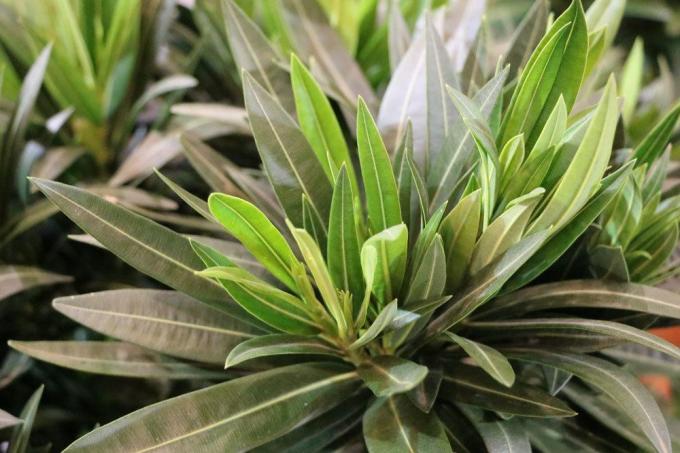
table of contents
- causes
- nutrient
- to water
- Old age
- Diseases
- Winter failure
- Location
- Saving oleanders
Suddenly the decorative oleander yellow leaves and it is completely unclear why this is so. However, the fact is that the plants often react to certain circumstances with yellow leaves. If the gardener is aware of these circumstances, he can react and counteract them with the appropriate care. There are many different factors why an oleander reacts with yellow leaves, because the plant has some special features in terms of growth and care.
causes
Determination of the cause
If the decorative plant suddenly shows yellow leaves, something is wrong with the care or the location. Because the oleander is usually evergreen and seldom loses its lush green leaves, but it can happen from time to time that they turn yellow. Nevertheless, it shouldn't become hectic, the causes can be checked calmly and processed using a checklist.
The following factors should be checked here:
- the location is too dark
- the oleander got frost
- a heat wave is currently ongoing
- the regular fertilization was forgotten
- the plant was attacked by pests
- the yellow leaves are more than two years old
If one or more of the care errors or points apply, then it is quite normal for the leaves to be thrown off. Because if the oleander doesn't get enough light, nutrients or water, then it has to protect itself. In order to maintain a supply, he sheds the leaves that have already turned yellow due to the shortage.
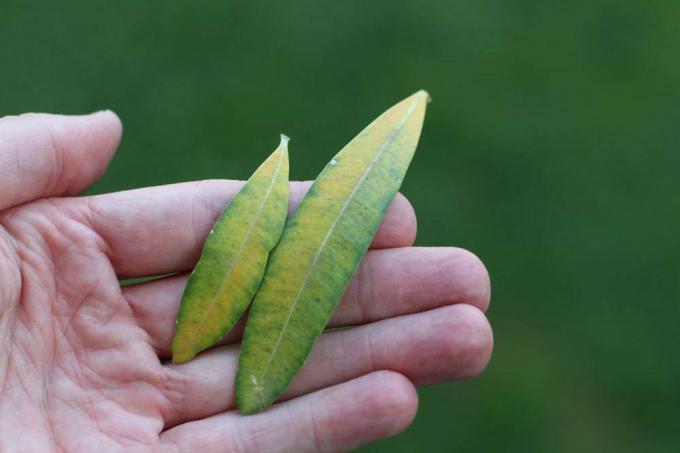
nutrient
Nutrients help
Oleander is often cultivated as a container plant in the local latitudes, as it is only partially hardy and can therefore be moved more easily to a protected location in winter. Therefore, oleander plants that have been cultivated in a pot need more fertilizer. If the Mediterranean plant does not receive enough nutrients, the leaves can turn yellow. But an oversupply is also quite possible here, to which the oleander reacts quickly. As a rule, however, the yellow leaves do not fall off, but stick. This shows that the plant is suffering from an undersupply or oversupply of nutrients. Therefore, when fertilizing the plants used in the bed, attention should be paid to the following in order to avoid yellow leaves.
- Oleander needs magnesium, iron and zinc
- Fertilize in the bucket every one to two weeks
- use special liquid fertilizers for oleanders
- Do not use commercially available potting soil for the tubs
- the oleander does not get the nutrients in it
- better mix garden soil with clay
- use slow release fertilizer for plants cultivated in beds
- only fertilize between May and August

If the oleander gets too many nutrients, this can also be a reason that the leaves turn yellow. Because the plant is very sensitive. Therefore, you should always pay attention to the correct mixture and proceed exactly according to the manufacturer's instructions for the fertilizer used. Giving too much or too little can unfortunately have unpleasant consequences for this plant. However, fertilizers specifically for oleanders are already available in stores, and these should also be used if necessary.
to water
Oleanders are originally native to the Mediterranean countries and are therefore used to high temperatures. Nevertheless, as a Mediterranean plant, it is one of those who have no problem standing in the wet for long periods of time. Because originally and in the wild, the plants grow on river plains. There is always a certain amount of soil moisture in the bank area. But that also means that the oleander does not want drought. If it is too dry, yellow leaves will quickly form. Therefore, the following points should always be observed when pouring.
- Pour daily over high heat
- in the early morning or late evening hours
- not on the leaves
- always from below to the roots
- pour when the water in the lower bowl has evaporated
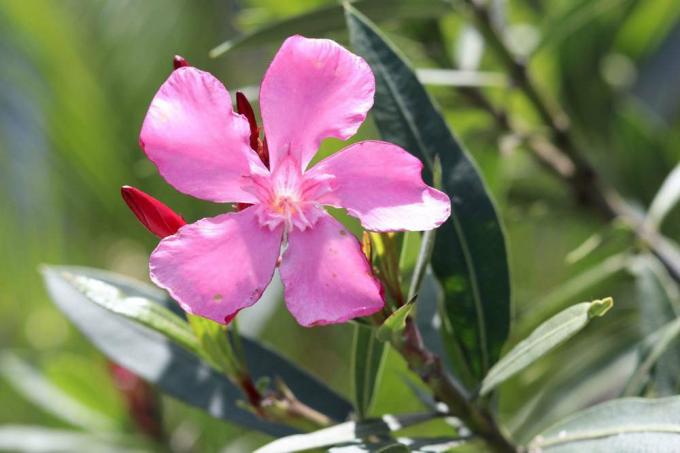
Of course, the plant should not be washed in so that the water is still above the ground and can be seen. Because even if the plant likes to be moist, it is not a water plant. It is therefore advisable to always water enough so that part of the water remains in the saucer, but the soil above remains only slightly damp to dry.
Old age
It is quite common on an evergreen plant for old leaves to turn yellow and shed. Only in this way can new, young leaves grow again. Because even if the oleander is an evergreen plant, this does not mean that the individual leaves live forever and remain on the plant. It is common for the oleander to shed its leaves after two to four years. That is, all leaves that are more than two years old will turn yellow and fall off in the next time. If there are only a few specimens, then this is mostly due to the age of the leaves. In this case, no additional maintenance is required. However, the following can be done to keep the shrub decorative.
- oldest leaves grow below
- if these are thrown off, nothing new grows back
- this can lead to balding
- stop balding by tapering cuts
- alternatively cultivate as a standard stem
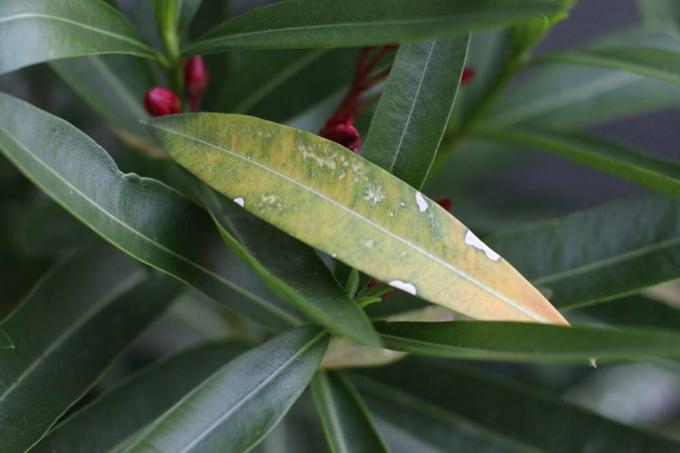
Diseases
Diseases and pests
The oleander can also suffer from various diseases and pests if it gets yellow leaves. However, diseases are quickly recognized by the fact that not an entire leaf but only parts or points on the leaf turn yellow. In such cases, it is mostly fungal diseases or oleander cancer caused by bacteria. In these cases, action must be taken quickly to prevent the diseases from spreading.
- remove all infected leaves
- also cut off all affected shoots
- do not add to the compost
- Dispose of in household waste
- use fungicides against fungal diseases
- Treat the plant and adjacent plants as a whole
- Oleander cancer usually occurs in winter quarters
- remove affected areas
- there is no remedy for bacterial attack
- strengthen the plant in such a case
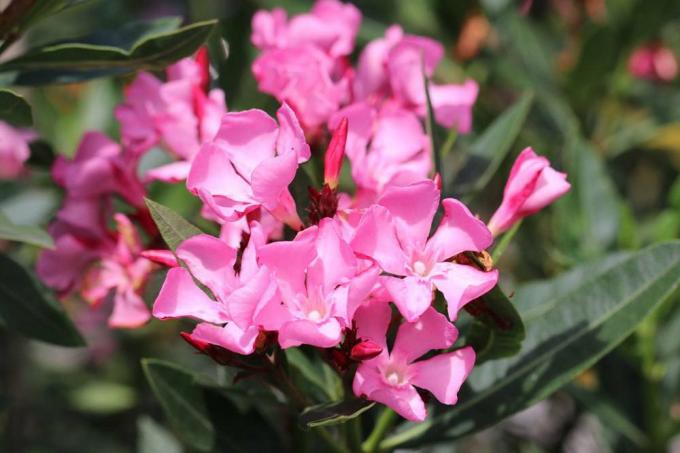
Scale insects in particular like to settle down on the oleander plant at home. These can, however, be expelled with an insecticide. Even in such cases, when the plants are attacked by pests and thereby develop yellow leaves, they should be strengthened overall. This includes, above all, brightness and warmth, enough water and not too many nutrients.
Winter failure
Yellow leaves on the actually evergreen oleander can also appear if the oleander is incorrectly overwintered. The plant, which is only partially hardy, must be protected from frost and cold moisture in the local latitudes. However, not every location is suitable in winter and can therefore also produce yellow leaves, which is usually completely normal if there are only a few yellow leaves. Because the oleander separates from excess leaves during the resting phase. In this way, he does not have to additionally supply these in winter, especially if the winter location is not ideal. The following should be observed when wintering Mediterranean plants.
- a light, moderately cool location is ideal
- the supply must also be given in winter
- moderate watering is compulsory
- protect against frost
- do not fertilize in winter
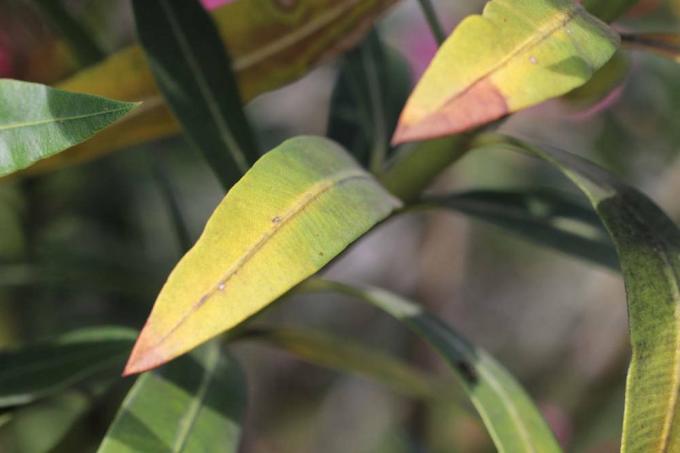
Oleanders are often described as slightly frost hardy, but this is usually not the case. Therefore, it should move to a frost-free winter quarters and not stay outside. Otherwise, only a radical cut back will usually help. If the first yellow leaves appear on an oleander that is still outside at the beginning of winter, it should be brought inside and protected as quickly as possible.
Location
Only if the ideal location for the oleander has been chosen will no yellow leaves appear. Since it is a Mediterranean plant, it is also used to the sun. The direct midday sun is also tolerated without problems if further care, such as watering, is correct. A sunny and sheltered place on a south or east balcony or on a sun-drenched terrace is ideal. Since it is recommended to cultivate the oleander in a tub due to its lack of winter hardiness, this also has many advantages for the summer location. Because in this way, depending on the weather, it can be pushed into the sun or protected from too much rain.
Saving oleanders
If the oleander looks more gray than green after overwintering and it has lost many leaves, it can still be saved. The same applies if he has received too many nutrients or has been very wet for a long time. In such a case, it should be removed from the bucket and cut.

The procedure is as follows:
- Cut the plant back to just above the stick
- take it from the bucket
- remove old and damp soil from the roots
- Let these dry slightly under certain circumstances
- Remove old soil from the pot and clean it well
- alternatively use a new container
- Pour in half of the fresh soil
- Insert the plant
- Add the rest of the soil, press down gently and water
- spend in a bright, warm, sunny location
Due to the radical pruning, it can take one to two years for the oleander to bloom again because the new ones Shoots that will form quickly from the cane will first have to age a little in order to bloom to train. Was it because of the water that caused damage to the oleander? Only water moderately for the first few weeks. The surface of the earth should not be soaked, but the water can remain in the plate. If too many nutrients have been given beforehand, then you should not fertilize in the first time after repotting. The nutrients in the fresh soil are then completely sufficient.

